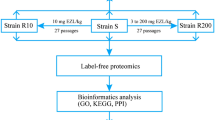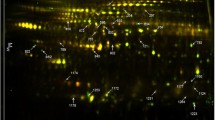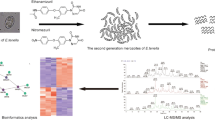Abstract
Polyether ionophores are widely used to treat and control coccidiosis in chickens. Widespread use of anticoccidials resulted in worldwide resistance. Mechanisms of resistance development and expansion are complex and poorly understood. Relative proteomic quantification using LC-MS/MS was used to compare sensitive reference strains (Ref-1, Ref-2) with putatively resistant and moderately sensitive field strains (FS-R, FS-mS) of Eimeria tenella after isotopic labelling with tandem mass tags (TMT). Ninety-seven proteins were identified, and 25 of them were regulated. Actin was significantly upregulated in resistant strains in comparison with their sensitive counterparts. On the other hand, microneme protein (MIC4) was downregulated in resistant strains. Optimization of labelling E. tenella sporozoites by TMT might identify further proteins that play a role in the obvious complex mechanism leading to resistance against Monensin.
Similar content being viewed by others
Avoid common mistakes on your manuscript.
Introduction
Eimeria tenella, an intracellular apicomplexan parasite, causes coccidiosis in chickens (McDougald and Fitz-Coy 2013). Monensin (Mon), a sodium polyether ionophore, is considered as the most frequently used polyether ionophore to control coccidiosis in chickens, including E. tenella (Chapman et al., 2010) Development of resistance of E. tenella to polyether ionophores against almost all compounds with market authorization for this indication has been reported (Stephan et al. 1997; Peek and Landman 2003). Mechanisms of this resistance are thought to be complex and are still not fully understood (Chen et al. 2008). Isobaric labelling using TMT is a gel-free technique to compare proteomes of multiple samples. After protein digestion, the produced peptides are labelled chemically with TMT reagents, equally combined, and analysed with LC-MS/MS. This enables comparative analysis of up to 10 samples in one single run based on the relative quantification of the sample-specific reporter ion abundance (Kuhn et al. 2012). For this purpose, two laboratory reference E. tenella strains (Ref-1 and Ref-2) with no history of exposure to anticoccidials and two E. tenella field strains (resistant FS-R, moderate-sensitive FS-mS) were used to compare proteomic profiles of their sporozoites using LC-MS/MS after TMT labelling. Anticoccidial sensitivity profiles of strains used in this study were previously determined (Thabet et al. 2017a).
Materials and methods
E. tenella Strains
Two laboratory reference E. tenella strains (Ref-1: Houghton and Ref-2: Wisconsin) with no history of exposure to anticoccidials and two field E. tenella strains isolated from field (FS-R and FS-mS) were used in this study. In vitro sensitivity profiles of these strains were previously tested against Mon and validated through in vivo anticoccidial sensitivity assay (Thabet et al. 2017a). Oocysts of field strains (FS-R and FS-mS) were passaged in chickens in presence of Mon (110 ppm), while the feed of chickens infected with reference strains contained no anticoccidials. Sporozoites were excysted and isolated from sporulated oocysts as described previously (Raether et al. 1995; Mattig et al. 1993).
Harvesting and lysis
Sporozoites of E. tenella strains used in this study were studied in triplicate (2.0 × 107 sporozoites/replicate). Cell lysate was prepared after washing each replicate twice with ice-cold PBS (1×) by resuspending cell pellets in 150 μl lysis buffer (100 mM triethylammonium bicarbonate (TEAB), 1.0% sodium dodecyl sulphate (SDS)) and incubation at 4 °C for 30 min with repeated vortexing. Protease inhibitor cocktail (Complete Mini, EDTA-free, Roche, Germany) was added to lysis buffer. Cell debris and non-dissolved material were removed by centrifugation (16,000×g, 18 °C, 5 min). Protein concentration was determined by Pierce™ BCA protein assay kit (Thermo Fisher Scientific, USA).
Reduction, alkylation, digestion, and labelling
Twenty-five micrograms of each replicate was used to compare reference (Ref-1, Ref-2) and field strains (FS-R, FS-mS) of E. tenella. Tandem mass tagging (TMT) was performed using TMT® 6-plex tagging kit (Thermo Fisher Scientific) following instructions of the manufacturer. Proteins were reduced with 10 mM tris (2-carboxyethyl) phosphine (TCEP) and alkylated with 375 mM iodoacetamide, prior to digestion into peptides with trypsin 2.5 μg/100 μg protein. Ref-1, Ref-2, FS-R, and FS-mS were labelled with TMT-128, TMT-129, TMT-130, and TMT-131, respectively. Three replicates of each strain were labelled with the corresponding tag. Sporozoites of each labelled E. tenella strain were mixed with those of the other strains at an equal ratio of 1:1:1:1. Samples were desalted using Spec PT C18 AR solid phase extraction pipette tips (Varian, Lake Forest, CA, USA) and reconstituted with 0.1% (v/v) formic acid for LC-MS/MS analysis.
nanoUPLC-MS/MS analysis
For TMT-labelled samples, 5 μl of each peptide solution was injected into the Dionex UltiMate 3000 RSLCnano system (ThermoScientific). The peptides were flushed with 2% ACN, 0.05% trifluoroacetic acid (TFA, v/v) on an Acclaim PepMap 100 column (75 μm × 2 cm, C18, Thermo Scientific) for 3 min. Peptide separation was performed by reversed phase LC on an Acclaim PepMap 100 column (75 μm, 25 cm, C18, ThermoScientific) by use of solvents A (0.1% FA (v/v)) and B (80% ACN (v/v), 0.08% FA (v/v)). A 120-min gradient was set with constant 4% B for 3 min, increase to 30% B for 47 min, increase to 55% B for 35 min, washing with up to 99% B for 15 min, and equilibration to 4% B for 20 min. The separated peptides were ionized by a chip-based electrospray device (TriVersa NanoMate ion source, Advion, Ithaca, NY, USA) at a voltage of 1.7 kV. MS full-scans were conducted using Q Exactive HF (ThermoScientific) at R = 120,000 setting the AGC target to 3 × 106 and the maximum injection time to 120 ms. The 15 most abundant ions exceeding a threshold of 5 × 104 were selected for fragmentation by Higher-energy C-trap Dissociation (HCD) at a normalized collision energy (NCE) of 33. MS/MS scans were conducted at R = 30,000 setting the AGC target to 5 × 105, the maximal injection time to 100 ms, and a fixed first mass at 120 m/z. The dynamic exclusion for MS/MS-scans was set to 30 s. MS/MS peak lists were generated by Xcalibur software (version 3.0, ThermoScientific).
Peptide and protein identification and quantification
MS/MS-data analysis was conducted using the Proteome Discoverer software (version 2.1, ThermoScientific). The acquired data were searched against the corresponding databases of E. tenella (Uniprot reference proteome knowledgebase, 8595 sequence entries, 16th August 2016) in target and decoy mode. The following search parameters were used: mass tolerance for precursor ions was set to 10 ppm and for fragment ion to 0.5 Da, respectively; two missed cleavages were allowed setting trypsin in specific mode; carbamidomethylation of cysteine was set as static modification, whereas oxidation of methionine and deamidation of asparagine and glutamine were set as dynamic modifications. The false discovery rate (FDR) for peptide spectrum matches (PSMs) and peptide identifications were set to 0.01. Identified proteins needed to contain at least one unique peptide and the FDR was set to 0.05. For quantification, the default method ‘TMT 6plex’ was used. If not stated otherwise, the default parameters of the software were used.
Data analysis
All abundance ratios gained from proteomic experiments were log2-transformed and median normalized to zero. To be considered as significantly regulated a protein needed to be quantified in 3 of 3 replicates, with a mean log2-fold change >0.5 or < −0.5 and a p value <0.05 (Student’s t test, two-tailed, unpaired).
Results and discussion
Development of resistance by Apicomplexa against polyether ionophores is known to be a slow and complex process (Chapman et al. 2010). Many proteins seem to play roles in the phenotypic establishment of resistance against polyether ionophores. Applying LC-MS/MS for proteomic evaluation of resistance has the advantage that a wide panel of proteins in complex biological systems can be analysed in one run.
Overall, 97 proteins were identified for E. tenella by at least one unique peptide (Supplementary Table 1) and 25 proteins were quantified in all three biological replicates. Thirteen regulated proteins were considered as proteins with FC <−0.5 or >0.5 and p < 0.05 (t test; Table 1). There was no significant difference between Ref-1 and Ref-2 strains concerning relative quantification of proteins. Relative quantification for FS-R in relation to Ref-1 (FS-R/Ref-1) revealed 8 regulated proteins and half of them were upregulated. Three proteins were upregulated in FS-R/Ref-2. Moreover, 4 and 2 proteins were upregulated in FS-mS in relation to Ref-1 and Ref-2, respectively. FS-mS versus FS-R revealed 5 regulated proteins, and 3 of them were upregulated. All regulated proteins for the various E. tenella strains are listed in (Table 2).
Actin (Fig. 1), a cellular transport protein, was significantly upregulated in FS-R compared to both Ref-1 and Ref-2. On the other hand, cytoskeleton actin depolymerising factor was downregulated in FS-R compared with all other E. tenella strains. This downregulation was significant in comparison with Ref-1. Actin upregulation in FS-R might reflect its role in evolvement of resistance against Mon. Actin participates actively in irreversible calcium-induced conoid extrusion during ionophore treatment in tachyzoites of Toxoplasma gondii (Del Carmen et al. 2009). Thus, the observed increase in actin in resistant strain might be linked to higher resistance to calcium-mediated structural dysfunction, induced primarily by the Na+-ionophore Mon.
Downregulation of actin depolymerizing factor (ADF) in FS-R compared with reference strains (significant in case of Ref-1) is directly associated with a high actin-turnover (Hotulainen et al. 2005). Suppression of ADF led to accumulation of actin-rich filaments and affected motility and invasion capability of Toxoplasma tachyzoites (Mehta and Sibley 2011).
As for T. gondii, microneme proteins are essential during host cell invasion by Eimeria spp. sporozoites and merozoites (Tomley et al. 2001; Lal et al. 2009). Microneme protein 4 (accession no. U6 L098) was downregulated in FS-R relative to Ref-1, Ref-2, and FS-mS. This downregulation was significant (Ref-1 and FS-mS; p < 0.05) or almost significant (Ref-2; p = 0.051In previous studies, a downregulation of the EtMIC3 gene was detected in resistant E. tenella but not for EtMIC1 (Chen et al. 2008). MIC8 protein was also downregulated in a Mon-resistant T. gondii strain relative to sensitive parental strain (Thabet et al. 2017b). MIC4, unlike other microneme proteins studied in E. tenella, is constitutively expressed in the surface of sporozoites and all merozoite stages (Tomley et al. 2001). In contrast, MIC3 proteins are expressed in free E. tenella stages (Labbé et al. 2005). Decrease of microneme proteins in resistant strain might indicate a lower invasion activity in comparison with reference strains. Besides that, downregulation of MIC4, a protein involved in the complex process of invasion, indicates that other proteins were probably missed during analysis.
Aspartyl proteinase (Eimepsin), pyruvate kinase, proteasome subunits, and transhydrogenase were generally upregulated in FS-R in comparison to both reference strains. Putative RAB GDP dissociation inhibitor alpha and Tsp1 domain-containing protein (TSP12) were significantly upregulated in FS-mS compared to Ref-2 and Ref-1 strain, respectively. Eimepsin is involved in a wide range of processes related to survival and was localized within E. tenella during invasion and first generation schizogony (Jean et al. 2000). Labbé et al. (2006) described relocalization of pyruvate kinase inside sporozoites and apex of first generation of merozoites in E. tenella under activating condition, which might be due to their particiopation in invasion process besides function in glycolysis during anaerobic intracellular stages.
MS/MS detection of 97 proteins in total represents a low percentage of the known proteomic profile of Eimeria. This could be attributed to the weak lysis buffer used for protein extraction from sporozoites as recommended by the TMT user’s guide. Lysis of sporozoites is generally achieved with amine-based reagents such as urea or thiourea as described elsewhere (Periz et al. 2007; Lal et al. 2009). However, detergents or primary amines affect efficacy of labelling with TMT and therefore a weak lysis buffer was used in this study. Besides that, most of proteins detected in FS-mS were non-regulated proteins in comparison with Ref-1 and Ref-2. Optimization of lysis buffer for E. tenella sporozoites during protein extraction would probably allow a more complete proteomic profile of resistant versus sensitive strains and might open the possibility to interpret mechanisms of partial resistance development. Moreover, an even more thorough analysis including more resistant strains and applying immunoblotting techniques on regulated proteins may enhance ability to verify the observed results of LC-MS/MS. However, such protocols remain to be implemented. Nevertheless, similarities in regulated proteins between Mon-sensitive and Mon-resistant strains were found by TMT for E. tenella as compared to a previously studied model of resistance in T. gondii (Thabet et al. 2017b).
Conclusion
By TMT labelling-based MS/MS analysis, several differences between Mon-resistant and non-resistant strains of E. tenella could be demonstrated. Higher expression of actin and downregulation of microneme proteins (MIC4) were common findings. Further attempts to increase TMT labelling efficacy in E. tenella are a prerequisite to further elucidate common mechanisms in apicomplexan resistance development on the proteomic level.
References
Chapman H, Jeffers K, Williams R (2010) Forty years of monensin for control of coccidiosis in poultry. Poult Sci 89:1788–1801
Chen T, Zhang W, Wang J, Dong H, Wang M (2008) Eimeria tenella: analysis of differentially expressed genes in the monensin- and maduramicin-resistant lines using cDNA array. Exp Parasitol 119:264–271
Del Carmen MG, Mondragón M, González S, Mondragón R (2009) Induction and regulation of conoid extrusion in Toxoplasma gondii. Cell Microbiol 11:967–982
Hotulainen P, Paunola E, Vartiainen M, Lappalainen P (2005) Actin-depolymerizing factor and cofilin-1 play overlapping roles in promoting rapid F-actin depolymerization in mammalien nonmuscle cells. Mol Biol Cell 16:649–664
Jean L, Grosclaude J, Labbé M, Tomley F, Péry P (2000) Differential localisation of an Eimeria tenella aspartyl proteinase during the infection process. Int J Parasitol 30(10):1099–1107
Kuhn K, Baumann C, Tommassen J, Prinz T (2012) TMT labelling for the quantitative analysis of adaptive responses in the meningococcal proteome. Methods Mol Biol 799:127–141
Labbé M, Venevelles P, Girard-Misguich F, Bourdieu C, Guillamue A, Péry P (2005) Eimeria tenella microneme protein EtMIC3 : identification, localisation and role in host cell infection. Mol Biochem Parasitol 140:43–53
Labbé M, Péroval M, Boudieu C, Girard-Misguich F, Péry P (2006) Eimeria tenella enolase and pyruvate kinase: a likely role in glycolysis and in other functions. Int J Parasitol 36:1443–1452
Lal K, Bromley E, Oakes R, Prieto J, Sanderson S, Kurian D, Hunt L, Yates JR, Wastling J, Sinden R, Tomley F (2009) Proteomic comparison of four Eimeria tenella life-cycle stages: unsporulated oocyst, sporulated oocyst, sporozoite and second-generation merozoite. Proteomics 9:4566–4576
Mattig F, Drössigk U, Entzeroth R (1993) A simple method for the purification of Eimeria tenella sporozoites. Appl Parasitol 34:139–142
McDougald L, Fitz-Coy S (2013) Coccidiosis: protozoal infections. In: Swayne DE (ed) Diseases of poultry, 13th edn. Blackwell, New York, pp 1148–1166
Mehta S, Sibley L (2011) Actin depolymerizing factor controls actin turnover and gliding motility in Toxoplasma gondii. Mol Biol Cell 22:1290–1299
Peek H, Landman W (2003) Resistance to anticoccidial drugs of Dutch avian Eimeria spp. field isolates originating from 1996, 1999 and 2001. Avian Pathol 32:391–401
Periz J, Gill A, Hunt L, Brown P, Tomley F (2007) The microneme proteins EtMIC4 and EtMIC5 of Eimeria tenella form a novel, ultra-high molecular mass protein complex that binds target host cells. J Biol Chem 282:16891–16898
Raether W, Hofmann J, Uphoff M (1995) In vitro cultivation of avian Eimeria species: Eimeria tenella. In: Eckert J, Braun R, Shirley M, Coudert P (eds) Biotechnology guidelines on techniques in coccidiosis. European Commission, Brussel, pp 79–92
Stephan B, Rommel M, Daugschies A, Haberkorn A (1997) Studies of resistance to anticoccidial in Eimeria field isolates and pure Eimeria strains. Vet Parasitol 69:19–29
Thabet A, Zhang R, Alnassan A, Daugschies A, Bangoura B (2017a) Anticoccidial efficacy testing: In vitro Eimeria tenella assays as replacement for animal experiments. Vet Parasitol 233:86–96
Thabet, A., Schmidt, J., Baumann, S., Honscha, W., von Bergen, M., Daugschies, A., Bangoura B (2017b) Resistance toward monensin is acquired in a Toxoplasma gondii model by reduced invasion and egress activities, in addition to increased intracellular replication. In press
Tomley F, Billington K, Bumstead J, Clark J, Monaghan P (2001) EtMIC4: a microneme protein from Eimeria tenella that contains tandem arrays of epidermal growth factor-like repeats and thrombospondin type-I repeats. Int J Parasitol 31:1303–1310
Acknowledgments
The authors would like to thank Helmholz Centre for Environmental Research (UFZ), particularly Prof. Martin von Bergen, Dr. Sven Baumann, and Johannes Schmidt for their technical support and advice. We thank also Prof. Damer Blake (The Royal Veterinary Colleges; University of London) and Dr. Alberta Lorraine Fuller (College of Agricultural and Environmental Science, The University of Georgia) for providing reference and field E. tenella strains. We would like to thank DAAD (German Academic Exchange Service) for supporting Ahmed Thabet.
Author information
Authors and Affiliations
Corresponding author
Ethics declarations
Conflict of interest
The authors declare that they have no conflict of interest.
Electronic supplementary material
ESM 1
(XLSX 147 kb)
Rights and permissions
About this article
Cite this article
Thabet, A., Honscha, W., Daugschies, A. et al. Quantitative proteomic studies in resistance mechanisms of Eimeria tenella against polyether ionophores. Parasitol Res 116, 1553–1559 (2017). https://doi.org/10.1007/s00436-017-5432-z
Received:
Accepted:
Published:
Issue Date:
DOI: https://doi.org/10.1007/s00436-017-5432-z





